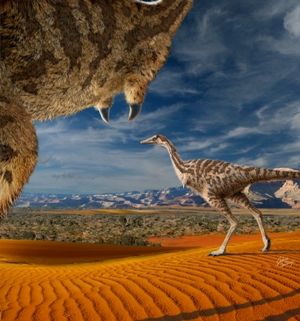
A team of international scientists, led by GSL Honorary Fellow Professor Xu Xing, have discovered a new species of parrot-sized dinosaur with only one finger on each hand – the first example of a dinosaur with only a single-digit, reports Sarah Day.
Geoscientist Online, 26 January 2011 A team of international scientists, led by GSL Honorary Fellow Professor Xu Xing, have discovered a new species of parrot-sized dinosaur with only one finger on each hand – the first example of a dinosaur with only a single-digit. The research is published in Proceedings of the National Academy of Sciences (PNAS).
The find was made during a research trip in Inner Mongolia, China, and provides an important insight into the evolution of a group of dinosaurs known as non-avian theropods. Named
Linhenykus monodactylus and belonging to the Alvarezsauroidea, a branch of the carnivorous group Theropoda, the new dinosaur is relatively small, capable of growing to about 60 centimetres and weighing about the same as a large parrot.
‘Alvarezsaurs like
Linhenykus usually have three fingers, with the first finger (our index finger) being considerably larger than the other two’ says Michael Pittman of the Department of Earth Sciences at University College London, co-author and discoverer of the specimen.
‘The presence of only one finger in
Linhenykus suggests that the other two fingers may have become less useful for these animals so
Linhenykus could afford to lack them’.
The evolution of non-avian theropods is thought to have begun with five-fingered limbs, which evolved to three fingers in later forms. The most famous of the theropods,
Tyrannosaurus, is unusual in having just two fingers.
‘One-fingered
Linhenykus now shows how extensive and complex theropod hand modifications really were’, says Pittman.
The fossil was found preserved in rocks of the Upper Cretaceous Wulansuhai Formation, dated to between 84 and 75 million years ago.
‘I found the specimen with my friend Dr. Jonah Choiniere who helpfully pointed out that I was about to step on most of the fragments as we were walking on a plain of sandstone in the Gobi desert’.
Considering the dinosaur’s small size, this is perhaps unsurprising.
‘Alvarezsaurs are very small dinosaurs’ explains Pittman. ‘They could have been very fashionable to carry in large shoulder bags if they were still around today’.
It is thought that they were digging insectivores, based on the comparison of their delicate skull, small teeth and strong arm bones with modern animals, as well as the presence of fossil termite mounds near to the discovery.
‘Linhenykus was living alongside other theropod dinosaurs such as the velociraptor-relative
Linheraptor exquisitus [a discovery
reported in Geoscientist in March last year].
Linhenykus being considerably smaller but in relative terms having longer legs than
Linheraptor was probably more agile and faster. This was definitely useful for avoiding being on the dinner menu’.
Michael Pittman was involved in the discovery of both dinosaurs whilst taking part in a research trip to Inner Mongolia led by Professor Xu Xing of the Chinese Academy of Sciences, and partly funded by the Geological Society. The trip formed part of the Inner Mongolia Research project, which aims to better understand the late Cretaceous ecosystem of Inner Mongolia.
On the discovery of
Linheraptor last year, he spoke of the importance of the funding he received.
“The Society has this great resource, funding fieldwork. The money I got was specifically for outdoor fieldwork, and funded my participation in the project. Without it, I wouldn’t have been able to go.”
- Listen to Michael Pittman talking about his discovery of Linheraptor exquisitus on episode 6 of the Geological Society podcast.
- Listen to Xu Xing and Michael Pittman discuss the Inner Mongolia Research Project on episode 7 of the Geological Society podcast.